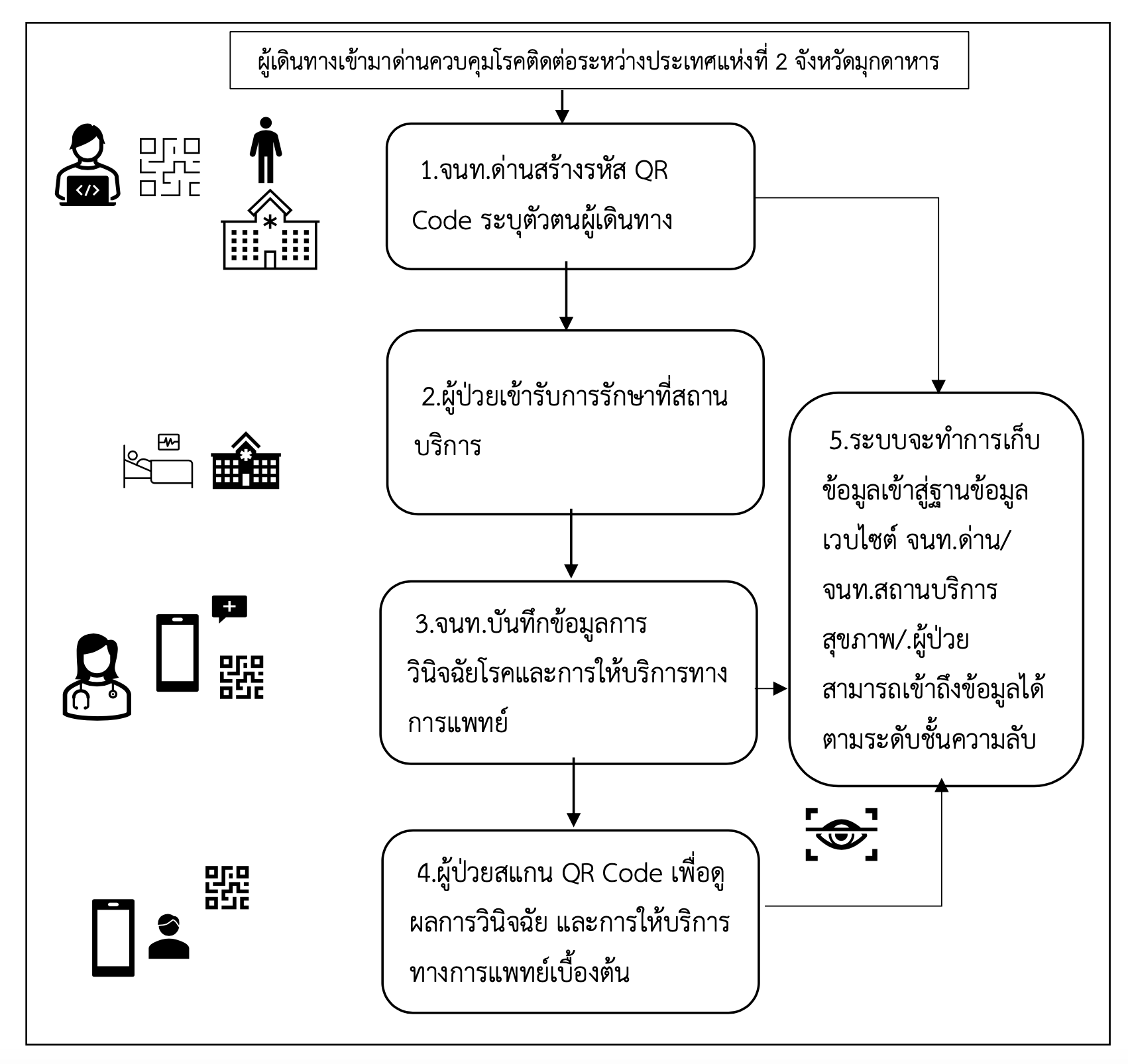การพัฒนาระบบตอบกลับการวินิจฉัยโรคของผู้ป่วยที่เดินทางผ่านด่าน ด้วย QR-CODE ในด่านควบคุมโรคติดต่อระหว่างประเทศ ของสำนักงานป้องกันควบคุมโรคที่ 10 จังหวัดอุบลราชธานี
Keywords:
development, response system, diagnosis, QR-CODEAbstract
Development of QR-CODE Diagnosis Response System for Patients Traveling as action research data. This study aims to Develop an effective QR-CODE diagnosis response system for patients who pass through the checkpoint. By gathering information from relevant persons who are checkpoint officials and 56 health service personnel in the area of Health Area 10, Ubon Ratchathani Province who agreed to cooperate in submitting information. During the walk in May - July 2019 and collected data from travelers who were a sample of 754 participants in the efficacy study. Collecting data with a situational review form Usage Consistency Questionnaire satisfaction questionnaire and data collection Descriptive statistics were used: number, percentage, mean, standard deviation.
The study found that The QR-CODE diagnosis response system of patients who travel through the checkpoint is suitable and meets the needs of the relevant parties at a high level. (=4.48, =0.74) and the effectiveness in the response rate of complete diagnosis information was 86.14% While analyzing the time of arrival, it was found that If entering the country no more than 3 days before the date of travel and after travel date The complete response rate in the patient group was up to 100%. Also found that users are satisfied with the overall diagnosis response system. was at the highest level, 94.64%. Especially in terms of usefulness to the work of the agency. and practical implementation The least aspect is that the form is appropriate to the context of the space, can be practical.
Recommendations for future is communicable disease surveillance system should be developed at checkpoints. to complement the existing system to be able to detect patients better in the future keywords; development, response system, diagnosis, QR-CODE and should be developed as an application To get sick travelers information linked to data from government health facilities and the private sector further.
References
กรมควบคุมโรค กฎอนามัยระหว่างประเทศ พ.ศ.2548 (2005) กรุงเทพมหานคร โรงพิมพ์องค์การทหารผ่าน
ศึกในพระบรมราชูปถัมภ์ 2548
ตินีจิต รัตนมงคล. (วันที่ 14 ตุลาคม 2564). อิทธิพลของความคาดหวังต่อคุณภาพการให้บริการทางอิเล็กทรอนิกส์ คุณประโยชน์ และความง่ายในการใช้งานที่ส่งผลต่อการยอมรับการใช้เทคโนโลยีในการชำระเงินผ่าน QR Code ของผู้บริโภคในจังหวัดกรุงเทพมหานคร.
พจนานุกรมฉบับราชบัณฑิตยสถาน. (2542). กรุงเทพฯ: นานมีบุค.
ประหยัด แดงสุภา (2541) ระบาดวิทยา: ระบาดวิทยาการแก้ไขปัญหาสาธารณสุขในชุมชน ประจวบคีรีขันธ์ ประจวบการพิมพ์ 14
รุ่งนภา จิตรโรจนรักษ์. (2548). การพัฒนารูปแบบการบริหารของคณะกรรมการสถานศึกษาขั้นพื้นฐานสำหรับประเทศไทย. กรุงเทพฯ: จุฬาลงกรณ์มหาวิทยาลัย/กรุงเทพฯ.
ลั่นทม จอนจวบทรง และ ณธภร ธรรมบุญวริศ. (2561). การใช้วิจัยปฏิบัติการในงานวิจัยทางระบบสารสนเทศ. วารสาร ธุรกิจปริทัศน์ ปีที่ 10 ฉบับที่ 2(กรกฎาคม-ธันวาคม 2561).
ศิราณี ศรีหาภาค และคณะ. (2561). รูปแบบการพัฒนาระบบบริการการแพทย์ฉุกเฉินสำหรับผู้สูงอายุภายใต้กองทุนระบบการดูแลระยะยาว จังหวัดขอนแก่น. สถาบันการแพทย์ฉุกเฉินแห่งชาติ (สพฉ.).
ศักดา สถาพรวจนา. (2549). การพัฒนารูปแบบการบริหารแบบมีส่วนร่วมของสถานศึกษาขั้นพื้นฐาน. กรุงเทพฯ: จุฬาลงกรณ์มหาวิทยาลัย/กรุงเทพฯ.
วีระยุทธ์ ชาตะกาญจน์. (2558). การวิจัยเชิงปฏิบัติการ.วารสารราชภัฏสุราษฎร์ฐานี ปีที่ 2 ฉบับที่ 1(มกราคม-มิถุนายน 2558).
อาบจิตร กอมาตย์ และคณะ.(2560). การพัฒนาระบบสารสนเทศเพื่อเพิ่มประสิทธิภาพระบบงานสารบรรณ. วารสารวิทยาลัยบัณฑิตเอเชีย ปีที่ 7ฉบับที่ 2 กรกฎาคม-ธันวาคม 2560.
อุทัย บุญประเสริฐ. (2546). การบริหารจัดการสถานศึกษาโดยใช้โรงเรียนเป็นฐาน. กรุงเทพฯ: จุฬาลงกรณ์มหาวิทยาลัย.
Bardo, J. W., & Hartman, J. J. (1982). Urban society: A systemic introduction. New York: Peacock.
Brown.W.
B., & Moberg, D. J. (1980). Organizational theory and management: A macro approach. New York: John Wiley & Sons.
DiMasi, J. A., Florez, M. I., Stergiopoulos, S., Peña, Y., Smith, Z., Wilkinson, M., & Getz, K. A. (2020). Development times and approval success rates for drugs to treat infectious diseases. Clinical Pharmacology & Therapeutics, 107(2), 324-332.
Getzels, J. W., & Guba, E. G. (1957, December). Social behavior and administrative process. School Review, 65, 423-441.
Joyce, B., & Weil, M. (1985). Models of teaching (2nd ed.). New Delhi: Prentice-Hall.
Keeves, P. J. (1988). Educational research, methodology and measurement: An international handbook. Oxford: Pergamon Press.
Longman. (1987). Longman Dictionary of Contemporary English. England: Clay.
Magteppong, W., Triamlumlerd, S., & Kongsuwan, P. (2022). การพัฒนาโมบายแอปพลิเคชันเพื่อประเมินและให้ความรู้ในการป้องกันและดูแลผู้ป่วยภาวะสมองเสื่อมสำหรับอาสาสมัครสาธารณสุขหมู่บ้าน. Thai Red Cross Nursing Journal, 15(3), 87-103.
Ormond, M., & Lunt, N. (2020). Transnational medical travel: Patient mobility, shifting health system entitlements and attachments. Journal of Ethnic and Migration Studies, 46(20), 4179-4192.
Ruiz, M. E. (2010). Risks of self-medication practices. Current Drug Safety, 5(4), 315-323.
Steiner, E. (1988). Methodology of theory building (pp. 39-40). Sydney: Educology Research Associates.
Willer, D. (1968). Scientific sociology: Theory and method. Englewood Cliffs, NJ: Prentice-Hall.

Downloads
Published
Versions
- 2023-01-01 (2)
- 2023-09-25 (1)
How to Cite
Issue
Section
License

This work is licensed under a Creative Commons Attribution-NonCommercial-NoDerivatives 4.0 International License.





